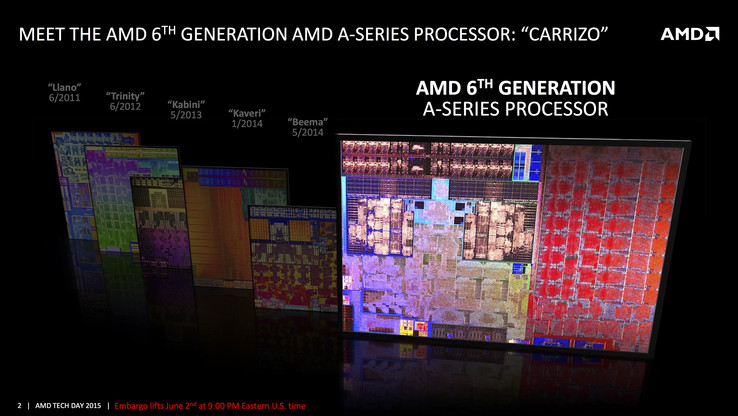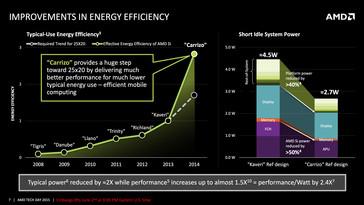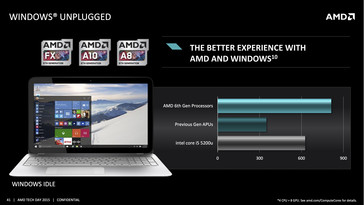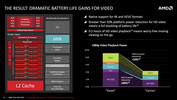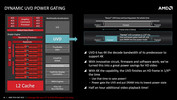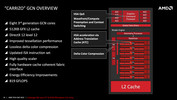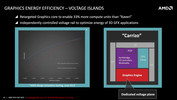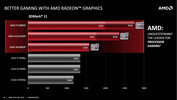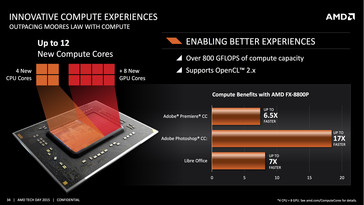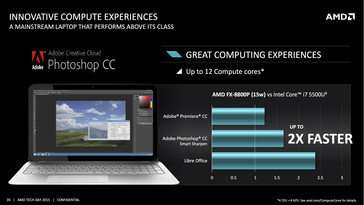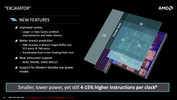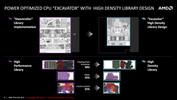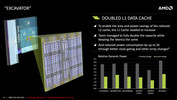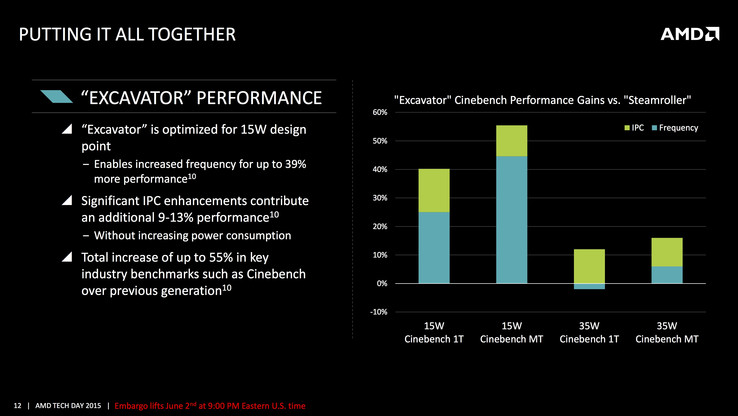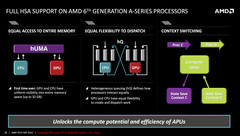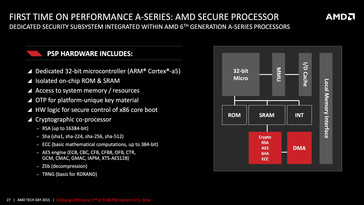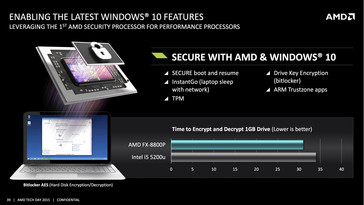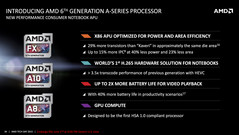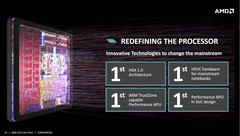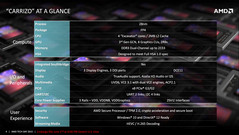AMD Carrizo Mainstream APUs Overview
For the original German article, see here.
The manufacturer announced three new APUs from the Carrizo-series. For the first time, these chips are full SoCs and can be operated in a TDP range between 12 up to 35 Watts. This also means the performance can differ significantly depending on the cooling solution. Similar to the Carrizo-L SoCs that are already available, the APUs are delivered in a compatible FP4 package and are directly soldered onto the motherboard.
AMD focused on an improved efficiency during the development and wants to score in the 15-Watt range in particular. The switches to a full SoC design, new "Excavator" processor cores with a higher package density and improved energy-saving features are supposed to result in a better performance combined with a lower consumption according to AMD. The typical power consumption is supposed to be reduced by the factor 2, even though the performance is 1.5x higher (19-Watt Kaveri FX-7500 vs. 15-Watt Carrizo FX-8800P in Cinebench). AMD also made significant progress in respect of the idle consumption. AMD claims that the Carrizo system manages a decrease from 4.5 to just 2.7 Watts compared to the Kaveri reference design, so Carrizo should be able to close the gap to Broadwell systems. AMD told us that they expect a similar runtime in Mobile Mark on comparable systems (6 hours Carrizo vs. 6.5 hours Broadwell).
More information about the efficiency improvements is available in our Carrizo Preview article.
Video
The video features of the SoC were a key topic for the reworked design. The new UVD 6 (Universal Video Decoder) now supports the decoding of HEVC/H.265 videos with up to 4K, and H.264 and MJPEG videos up to 4K can now be accelerated by the hardware as well. You still get support for 1080p VC-1/WMV profile D, MPEG-2, Multi-View Codec (MVC) and MPEG4/DivX. This means the Carrizo APUs are the first mainstream processors that support HEVC. Intel’s Broadwell CPUs only support a hybrid model where CPU and GPU cores work together, so you might need a powerful Core i7 processor for smooth playback depending on the bitrate. Intel’s recently launched Cherry Trail Atoms also have hardware support for HEVC, but a test video did not run smoothly in our review of the Microsoft Surface 3.
Another important aspect of the new UVD 6 was once again the power consumption. 1080p videos can now be decoded without the utilization of the graphics card. The UVD can also go to sleep between the decoding of two frames (Power Gate). This reduces the power consumption significantly (from almost 5 Watts with Kaveri to around 2 Watts with Carrizo), which means that the battery runtime could be doubled according to AMD.
The transcoding performance of the APU was noticeably increased as well and is also supposed to beat Quick Sync with 1080p videos according to AMD. A Handbrake version with support for AMD’s VCE conversion was also announced.
Integrated GCN Graphics Card
Carrizo uses the latest version of the GCN graphics core. The most important improvements of the third generation compared to the predecessor are:
- Improved tessellation performance
- Lossless delta color compression
- Improved efficiency
You still get 512 shaders that can deliver up to 819 GFLOPS in the 35-Watt top version.
The graphics performance over Kaveri was noticeably improved for the 15-Watt processor in particular. The 3DMark 11 results can be up to 65% higher in this scenario. The faster 35-Watt model still has an advantage of around 15% thanks to slightly improved clocks and GCN improvements.
The often criticized dual-graphics could become more important with DirectX 12, because games can natively access multiple and different graphics cores.
Processor Cores
The Carrizo APUs use the new Excavator processor cores for the first time, which is the latest iteration of Bulldozer before there will be a completely new architecture called Zen next year. Thanks to improved caches and a better branch prediction, the IPC (instructions per clock) performance is supposed to be improved by 4-15% (even though the L2 cache is smaller). The Excavator cores also support new instructions (AVX2, MOVBE, SMEP and BMI1/2) and Connected Standby.
You can clearly see the improvements over Kaveri's Steamroller cores in the Cinebench tests from AMD. The new Excavator cores are 40% up to 55% faster (single-core and multi-core, respectively) in the 15-Watt version in particular, but a big part of the improvement is realized with higher clocks (25% and 45%, respectively). The clock increase is pretty small in the 35-Watt version (even a small reduction for a single core), but the improvements of the IPC performance are still there and result in 13% and 10% higher results.
HSA 1.0
Carrizo is the first processor in the world that supports version 1.0 of the HSA standard, which allows a better cooperation of the processor and graphics cores. There is currently no popular software that can utilize it, but certain features were and will be implemented by Intel, so it is a pretty future-proof feature.
Business Features
Verdict
AMD wants to be successful with Carrizo in the 15-Watt range in particular, and according to the released data and benchmarks, this seems to be a success. The CPU and GPU performances could be increased significantly in this TDP range. This is a result of the numerous energy-saving features and the full SoC design. But the 35-Watt versions can benefit from those improvements as well. In addition, you get the new features like the UVD 6 Video Engine including the future-proof HEVC decoder, HSA 1.0 support and the TrustZone security processor. Without a dedicated graphics card, the Carrizo APUs seem to be an interesting alternative to Intel’s Core i3 – i5 in the price range between $400-$700 thanks to the powerful graphics, compute and multimedia performance. Our in-depth reviews will show how the APUs perform in available notebooks. AMD currently expects the launch of new devices from Acer, Asus, Dell, HP, Lenovo and Toshiba between July and August 2015.




